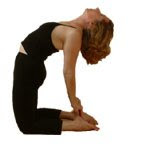 I went with a friend to her yoga class today and while I was in Salamba Sarvangasana I began to reflect on the pose and its benefits. Salamba Sarvangasana is known as the Mother of asanas. The translation begins with “alamba” which means a prop or support. Combined with “sa”, which means together or accompanied by, Salamba means supported or propped up. Sarvanga is the combination of “sarva” which means all, whole, entire, or complete and “anga” which means limb or body. The name “whole body pose” is appropriate since the whole body benefits from this pose.
I went with a friend to her yoga class today and while I was in Salamba Sarvangasana I began to reflect on the pose and its benefits. Salamba Sarvangasana is known as the Mother of asanas. The translation begins with “alamba” which means a prop or support. Combined with “sa”, which means together or accompanied by, Salamba means supported or propped up. Sarvanga is the combination of “sarva” which means all, whole, entire, or complete and “anga” which means limb or body. The name “whole body pose” is appropriate since the whole body benefits from this pose.The ancient sages bestowed upon the world a pose that strives to achieve harmony and happiness in our human system, just like a mother endeavors to have a harmonious and happy home. It has been spoken of it as a “panacea for most common ailments”. The thyroid and parathyroid glands in the neck region are stimulated so that they function properly and help to balance and develop the body and brain. The pose increases circulation of blood and lymphatic fluid around the neck and chest which can help people who suffer breathlessness, palpitations, asthma, bronchitis, and throat ailments. It can help to soothe nerves and ease headaches and colds. Insomnia and constipation can be relieved. If you regularly practice Salamba Sarvangasana you can feel renewed vigor and strength as the energy flows in your body and your mind. People who suffer from high blood pressure however, should not do this pose.
As I came out of shoulder stand, I experienced that sense of balance and energy flow that I have often told my students about in class. I was at peace, happy, and energized for my day. It was a fabulous reflection of how each pose we do in our yoga practice brings benefits to our body, our mind, and our spirit.
Below are some variations of Salamba Sarvangasana. If you have not practiced this pose before, be sure to get some direction from a yoga teacher who can help you find a beginning variation that is suitable and who can then help you to progress through other variations to whatever expression of the pose is best for you.







